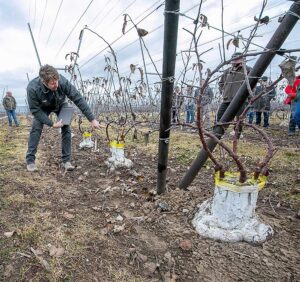—by Ross Courtney

Cornerstone Ranches likes to stick with what works.
About 20 years ago, farm owner Graham Gamache and his veteran orchard manager, Javier Ramos, were introduced to a three-leader V-trellis orchard system and liked that it simplifies pruning and thinning, keeps fruit close to the leaders and controls vigor while maintaining nutrient flow to the fruit. They stuck with it to keep management simple and consistent.
Today, they rarely use anything else.
“We were lucky enough to stumble into something that works, and it keeps working for us,” Gamache said.
Brand new blocks, recently grafted blocks and 20-year-old (or older) blocks all get the same treatment. Variety, rootstock and spacing rarely change the decision.
The farm west of Wapato in Washington’s Yakima Valley grows WA 38, Fuji, Granny Smith and Golden Delicious apples.


The farm’s dedication to consistency inspired the International Fruit Tree Association to include Cornerstone as a tour stop during its 2024 winter conference in Yakima in February. “This farm was schooled on the ‘If it ain’t broke, don’t fix it’ belief, and it has served them well over the decades and natural, cyclical rhythms of the agricultural industry,” Dave Gleason, the tour organizer, wrote in the tour stop notes.
Gamache is a fifth-generation farmer in the Yakima Valley but the third to grow specialty crops on the farm now known as Cornerstone. His grandfather, Amos Gamache, purchased the apple orchard in 1982 when it was just one block of Oregon Spur, which the family later grafted to Golden Delicious. The family expanded into different varieties and planting systems. In the late 1990s, Brian Nobbs, now a co-owner of Mike and Brian’s Nursery, worked at the farm and helped usher in the three-leader V-trellis system.
Graham Gamache, a youngster at the time, worked shifts in the blocks under the direction of Ramos. He took over the farm in 2013 and renamed it Cornerstone Ranches but continued with the training system.
Pruning the three-leader
One of Cornerstone’s crown jewels is “The Money Block,” a 2004 Golden Delicious block that yields 105 bins per acre. After 20 years, the mature three-leaders have bumped into each other in places, so Ramos has had to cut some back, he said. The space is still full.
Across one orchard road sits a 2023 graft of Braeburn to Goldens on M.26, three short, future-leaders protruding from the wax of each union. Another neighboring block is a 2024 graft of Braeburn to WA 38 on M.26.

Ramos, who has worked at the farm for 37 years, communicates the pruning instructions to crews.
He instructs them to renew any thick branches and create between 6 and 9 inches of space between “stack” laterals, enough room for an apple to hang with no risk of limb rub. The 1-year-old wood he tells pruners to cut to 9 inches or shorter. He and other supervisors decide how many buds per tree they want, based on trunk diameter, and convert that into spacing instructions for the pruners.
Over the years, the farm has made the trellis Vs steeper, going from a 6-foot crossbeam to a 4-foot beam. The change allows for more light and input exposure to the fruiting side of the V and prevents fruit set on the inside, where it would be hard to reach for thinning and picking.

Open to innovation
The tried-and-true philosophy does not mean Cornerstone opposes innovation.
The farm is usually conservative with technological adoption, but they have begun using defoliators and find that the V system accommodates those.
The farm packs with Washington Fruit and Produce Co., which is advising Gamache, Ramos and their team how to implement its aggressive method of pruning based on bud count.
Andrew del Rosario, Washington Fruit’s horticulture consultant, said he is assisting the Cornerstone team to prune to a firm bud count — one bud to one fruit for Gala and Cripps Pink, and 1.1-to-1 for Fuji — to boost size and quality. He also is helping the farm refine manual blossom thinning of Gala trees this year.

One exception: “We’re not touching their Goldens,” del Rosario said with a laugh. Cornerstone is known for its Golden Delicious quality and yields.
Any multileader system can lack uniformity, making bud counts difficult, but the farm’s three-leader system will work, del Rosario said. Washington Fruit has some of its own three-leader blocks, too.
Also, it’s not unusual for farmers to “get married” to a tree architecture and stick with it, del Rosario said.
Gamache is implementing del Rosario’s technical bud counting in stages but believes his three-leader system can handle the math.
“We’ve had many cultural practice changes, from pruning styles to blossom thinning,” Gamache said. “And we find that whatever the market or our management mood is, it finds itself to be adaptable.”
